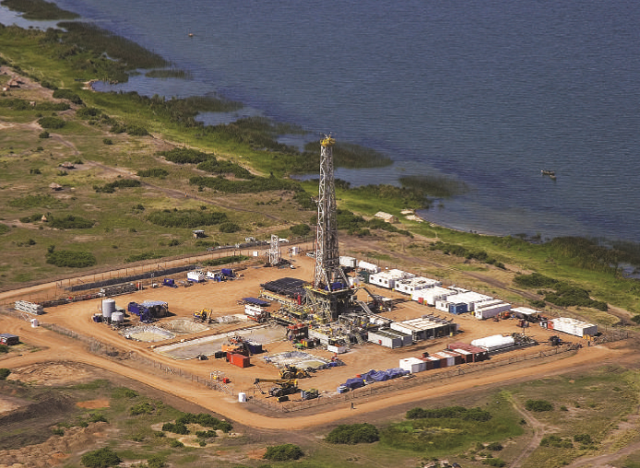
But will oil companies pump money into key infrastructure projects to meet new first oil timeline?
Kampala, Uganda | RONALD MUSOKE | Uganda’s oil and gas industry is expected to rake in investments worth over US$ 1 billion this year,according to senior energy ministry officials.
The outlay for this year is part of the close to US$20bn that the government expects over the next three years as the joint venture oil company partners step up activities to commercialize Uganda’s petroleum resources which were discov¬ered over a decade ago.
The development of the upstream proj¬ects are being taken forward by the three joint venture partners, CNOOC Uganda Ltd, Total E&P Uganda and Tullow Uganda Operations Pty Ltd.
Eng. Irene Muloni, the Minister of Energy and Mineral Development said recently that the government expects a pick-up in activity in the sector this year following a calm 2018 that involved designs of key production infrastruc¬ture such as the East African Crude Oil Pipeline and the two central processing facilities.
She said the government has also revised its timelines for first oil by 24 months to 2022 following a series of missed deadlines.
According to the government’s original road map, first oil was scheduled for 2020 but the joint venture oil companies failed to submit their final investment decisions in time. Muloni said the gov¬ernment had expected the key decisions to be made latest end of 2017 or in the first quarter of 2018.
“Unfortunately, it has not happened and 2018 has come to an end,” Muloni said, “That means Uganda’s first oil shifts.”
At the time the government announced the 2020 first oil timeline; many observers said the schedule was quite ambitious considering the range and cost of infrastructure involved.
In the field, for instance, oil companies needed to develop infrastructure to produce the oil. These included drilling and completing more than 400 wells, setting up two central processing facili¬ties, laying of over 200km of in-field flow lines, laying approximately 150km of feeder pipelines, construction of base camps and minor access roads, among others.
Besides the crude oil pipeline and refinery development, the oil companies had to do Front End Engineering Designs before making their final investment decisions for the two central processing facilities.
These include the Tilenga project which covers Buliisa and Nwoya districts and the Kingfisher project which covers Hoima and Kikuube districts—both esti¬mated to cost about US$ 8 billion.
The Tilenga project will have a pro¬cessing facility with capacity of up to 190,000 barrels of oil per day and the Kingfisher project, 40,000 barrels per day. These processing facilities will feed into the refinery and the 1,445km crude oil pipeline.
But putting in place the essential mid¬stream infrastructure, including a 60,000 barrels per day Greenfield refinery, a crude oil export pipeline and a products pipeline—facilities needed almost at the same time— has proved difficult.
The government only managed to find investors for the US$4bn oil refinery in Hoima in April, last year, following the signing of a project framework agree¬ment between the government and a consortium of companies led by the US giant, General Electric (G.E).
The Albertine Graben Refinery Con¬sortium is comprised of YAATRA Africa (Mauritius), Lionworks Group Limited (Mauritius), Nuovo Pignone Interna¬tional SRL (a General Electric company domiciled in Italy) and SAIPEM SPA (Italy).
Josephine Wapakhabulo, the Chief Executive Officer at the Uganda National Oil Company (UNOC) referred to the signing ceremony as a “game changer” for the country.
But the agreement only became effec¬tive from Sept.7, 2018, and the con¬sortium is now undertaking technical studies (FEED and ESIA) together with other pre-FID activities such as devel¬oping a financing strategy, financial modelling, raising capital and risk anal¬ysis and the supply and demand consid¬erations for the project.
Muloni said the government has given the refinery consortium a maximum of two years to reach a FID after which they will embark on construction of the refinery. It is expected to be ready in 2023.
 The Independent Uganda: You get the Truth we Pay the Price
The Independent Uganda: You get the Truth we Pay the Price



